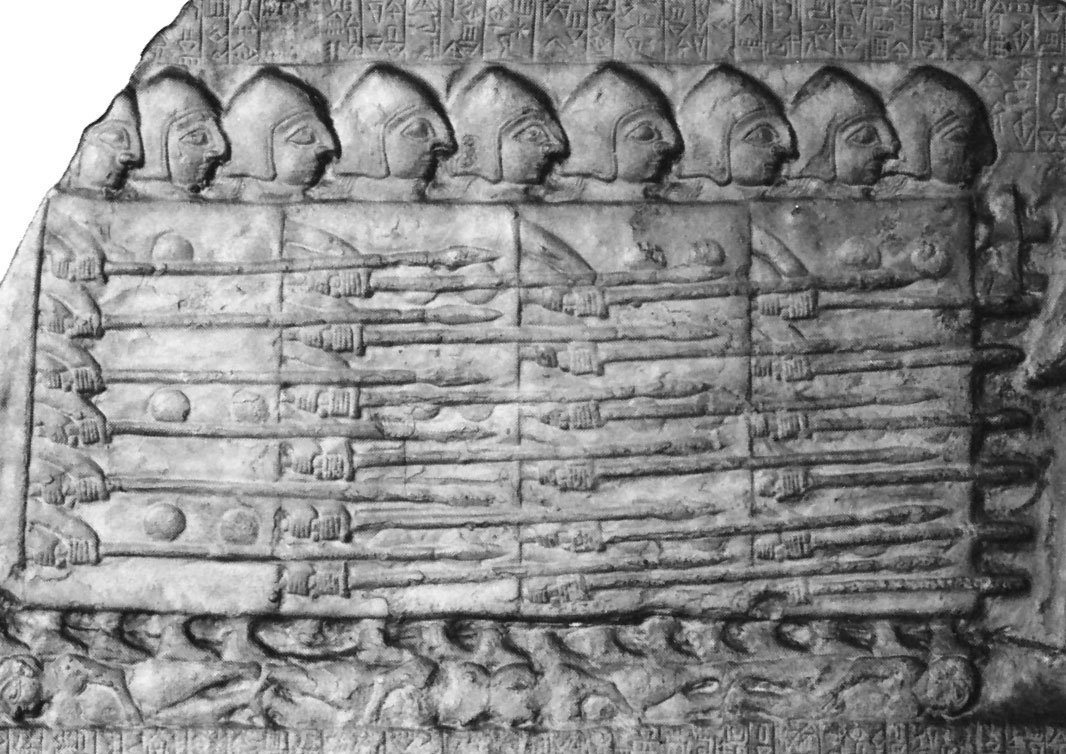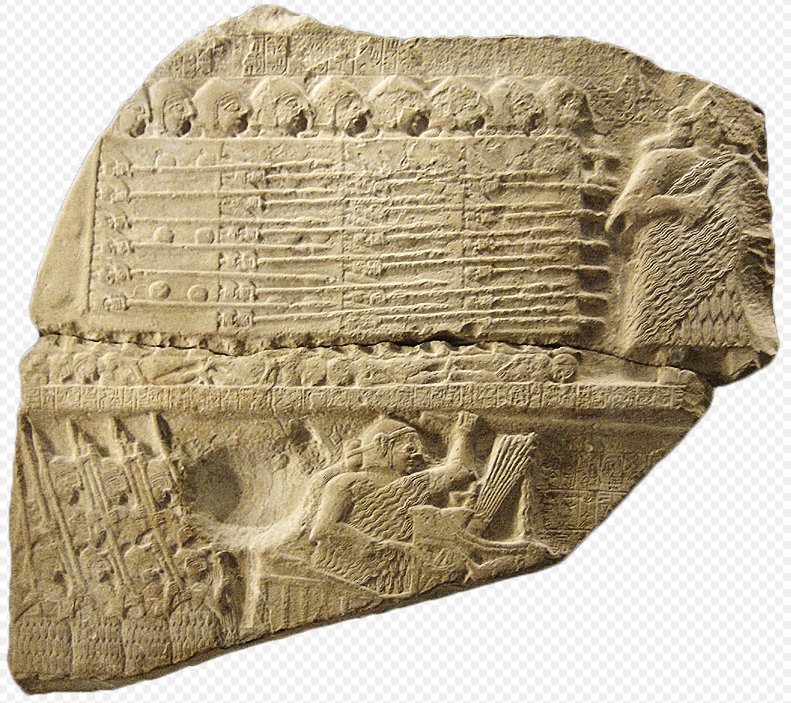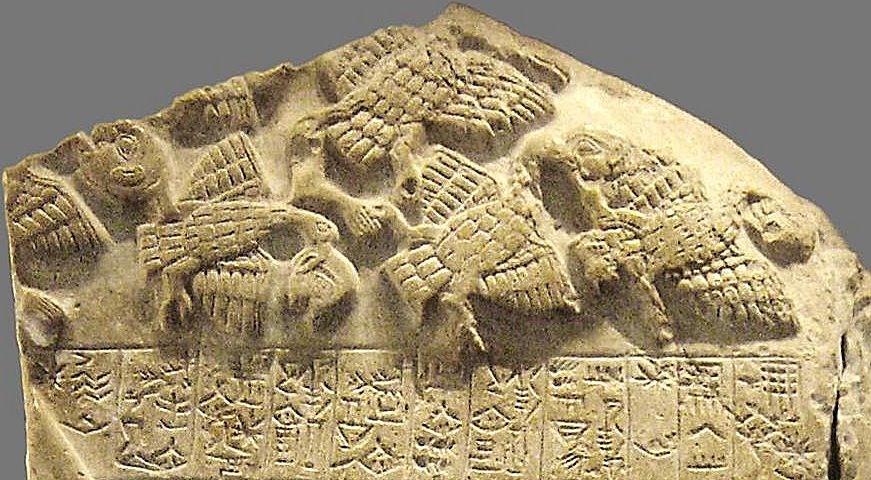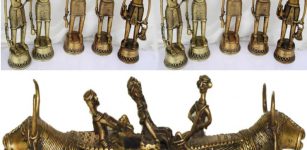Sumerian Stele Of The Vultures: Oldest Known Historical Records Carved On Limestone
A. Sutherland - AncientPages.com - The Stele of the Vultures is the Sumerian historical and literary work dated to the Early Dynastic III period (2600–2350 BC).
Also known as Eannatum’s Stele of Vultures, the artifact is fragmentary but it was once carved out of a single slab of limestone. The stele was commissioned by Eannatum, a powerful Sumerian ruler of Lagash around 2460 BC.

Sumerian phalanx, c. 2500 BC. A block of foot soldiers, standing shield-to-shield and presenting spears, advances in a dense mass typical of the phalanx. From the Stele of the Vultures, limestone bas-relief, c. 2500 BC. In the Louvre, Paris.Giraudon/Art Resource, New York. Image via Britannica
The king of Lagash, Eannatum, conquered all of Sumer and established one of the first verifiable empires in history. Eannatum even expanded his enormous influence beyond the boundaries of Sumer and during his reign, many palaces and formidable temples were built, especially in the city of Lagash.
It contains only seven pieces; the first three fragments were unearthed during excavations in the early 1880s by the French archaeologist Ernest de Sarzec (1832–1901) credited with the discovery of the civilization of ancient Sumer.
The place of the discovery is the mound of Tello (ancient Girsu) in what is today southern Iraq.
The excavations of 1888–1889, revealed another three fragments and finally, the last fragment was also discovered and later determined to be part of the Stele of the Vultures, the oldest known historical document.

One fragment of the victory stele of the king Eannatum of Lagash over Umma, Sumerian archaic dynasties. Image credit: Sting - CC BY-SA 3.0
The Stele of the Vultures commemorates a victory of the city-state of Lagash over its neighboring city of Umma and depicts several religious, mythological, and historical scenes, and battles; the artwork was created during the time when the Sumerian artists commemorated important military victories, are celebrated on stone monuments.
The stele’s name relates to the vultures depicted in one of these scenes. The vultures are depicted with severed human heads in their beaks and a fragment of cuneiform script.

A fragment of the Stele of the Vultures showing vultures with severed human heads in their beaks and a fragment of cuneiform script. Image credit: Sting - CC BY-SA 3.0
The only seven fragments are known today and they are on display in the Louvre.
As reconstructed, the complete monument – decorated with carved reliefs on both sides - was probably 1.80 meters (5 ft 11 in) high, 1.30 meters (4 ft 3 in) wide, and 0.11 meters (4.3 in) thick and had a rounded top.
A very similar monument is the Victory Stele of Naram-Sin, created during the Akkadian period that followed on the Early Dynastic III period.
Unfortunately, the inscriptions on the Stele of the Vultures - written in the Sumerian cuneiform script - are not well-preserved and much of Sumer’s historical data is missing.
Written by – A. Sutherland - AncientPages.com Senior Staff Writer
Copyright © AncientPages.com All rights reserved. This material may not be published, broadcast, rewritten or redistributed in whole or part without the express written permission of AncientPages.com
More From Ancient Pages
-
 Karahunge – ‘Speaking Stones’ With Secrets – Remarkable Prehistoric Structures Of Armenia
Places | Jun 4, 2020
Karahunge – ‘Speaking Stones’ With Secrets – Remarkable Prehistoric Structures Of Armenia
Places | Jun 4, 2020 -
 Mysterious Biblical Canaanites – What Ancient DNA Reveals About Their Fate
Archaeology | Jul 28, 2017
Mysterious Biblical Canaanites – What Ancient DNA Reveals About Their Fate
Archaeology | Jul 28, 2017 -
 Ancient Gymnasium Discovered In Egypt
Archaeology | Nov 6, 2017
Ancient Gymnasium Discovered In Egypt
Archaeology | Nov 6, 2017 -
 Startling Discovery Of Nubian Levallois Technology In Shukbah Cave Re-Writes Ancient History Of Neanderthals And Homo Sapiens
Archaeology | Feb 24, 2021
Startling Discovery Of Nubian Levallois Technology In Shukbah Cave Re-Writes Ancient History Of Neanderthals And Homo Sapiens
Archaeology | Feb 24, 2021 -
 Tricksters: Mischievous Troublemakers Making Attempts To Help And Hinder In Mythologies Of Ancient Cultures
Featured Stories | Oct 28, 2019
Tricksters: Mischievous Troublemakers Making Attempts To Help And Hinder In Mythologies Of Ancient Cultures
Featured Stories | Oct 28, 2019 -
 World’s Oldest And Largest Maya Structure Revealed By LIDAR
Archaeology | Jun 9, 2020
World’s Oldest And Largest Maya Structure Revealed By LIDAR
Archaeology | Jun 9, 2020 -
 Polycarp Of Smyrna: Burned At The Stake And Pierced With A Dagger
Featured Stories | Jun 25, 2020
Polycarp Of Smyrna: Burned At The Stake And Pierced With A Dagger
Featured Stories | Jun 25, 2020 -
 Biblical Prophet Jeremiah Whose Prophecies Disappointed People
Biblical Mysteries | Jan 30, 2019
Biblical Prophet Jeremiah Whose Prophecies Disappointed People
Biblical Mysteries | Jan 30, 2019 -
 Ancient Native Americans’ Encounter With The Star People – An Otherworldly Rescue?
Ancient Mysteries | Jul 20, 2021
Ancient Native Americans’ Encounter With The Star People – An Otherworldly Rescue?
Ancient Mysteries | Jul 20, 2021 -
 1,500-Year-Old Joint Burial Offers A Look Into Attitudes Toward Love And The Afterlife
Archaeology | Sep 14, 2021
1,500-Year-Old Joint Burial Offers A Look Into Attitudes Toward Love And The Afterlife
Archaeology | Sep 14, 2021 -
 Telangana And Great Ancient Iron Masterwork Of Skilled Blacksmiths Of India
Ancient Technology | May 26, 2017
Telangana And Great Ancient Iron Masterwork Of Skilled Blacksmiths Of India
Ancient Technology | May 26, 2017 -
 Falerii Novi – Huge Ancient Underground Roman City Reveals Its Secrets
Featured Stories | Jun 8, 2022
Falerii Novi – Huge Ancient Underground Roman City Reveals Its Secrets
Featured Stories | Jun 8, 2022 -
 Hathor – One Of Ancient Egypt’s Greatest Female Deities
Egyptian Mythology | Jun 16, 2021
Hathor – One Of Ancient Egypt’s Greatest Female Deities
Egyptian Mythology | Jun 16, 2021 -
 Ancient Romans Used The Poisonous Black Henbane Plant As Hallucinogenic Medicine
Archaeology | Feb 9, 2024
Ancient Romans Used The Poisonous Black Henbane Plant As Hallucinogenic Medicine
Archaeology | Feb 9, 2024 -
 Hundreds Of Exceptional Bronze Age Artifacts Discovered In France Were Probably Offerings
Archaeology | Aug 28, 2021
Hundreds Of Exceptional Bronze Age Artifacts Discovered In France Were Probably Offerings
Archaeology | Aug 28, 2021 -
 Exceptional Precision And Technical Mastery Of Iberian Archery From 7,000 Years Ago
Archaeology | Dec 27, 2024
Exceptional Precision And Technical Mastery Of Iberian Archery From 7,000 Years Ago
Archaeology | Dec 27, 2024 -
 Large Underwater Site That Was Home To 500,000 People About 14,000 Years Ago Identified Northwest Of Australia
Earth Changes | Jan 17, 2024
Large Underwater Site That Was Home To 500,000 People About 14,000 Years Ago Identified Northwest Of Australia
Earth Changes | Jan 17, 2024 -
 Dark And Light Sides Of Pax Romana: Great Political Slogan Introduced After Civil Wars
Ancient History Facts | May 20, 2023
Dark And Light Sides Of Pax Romana: Great Political Slogan Introduced After Civil Wars
Ancient History Facts | May 20, 2023 -
 Oldest case of leukemia found on 7,000-Year-old skeleton
News | Aug 23, 2015
Oldest case of leukemia found on 7,000-Year-old skeleton
News | Aug 23, 2015 -
 3,000-Year-Old Recycling Center In What Is Now Dubai – Discovered
Archaeology | Jan 8, 2020
3,000-Year-Old Recycling Center In What Is Now Dubai – Discovered
Archaeology | Jan 8, 2020
